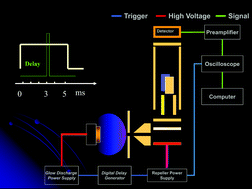Ion intensity profiles, for both discharge gas (40Ar2+, 40Ar+, 40Ar+2) and sputtered species (63Cu+), have been measured for a series of parameters including sampling distance, pulse power, discharge gas pressure, pulse width, and duty cycle in a millisecond pulsed direct current (dc) glow discharge plasma using time-gated detection with a time-of-flight (ToF) mass spectrometer. Throughout these experiments constant power was maintained for comparative profile measurements. Intensity profiles for both discharge gas and sputtered material were constructed using the intensity values from a compilation of over 100 mass spectra. Ion signals from analytically important (sputtered) species differed in their response to changes in sampling distance, discharge gas pressure, pulse width, and duty cycle than those of discharge gas species. These intensity profiles provide insight into the effects of discharge conditions on the time-dependent behavior of different ions in the plasma. In addition to using time-gated acquisition, it is possible to further influence ion formation within the plasma through the careful selection of these plasma parameters; in doing so, one can maximize sputtered ion signals while suppressing ion signals from discharge gas species. In this research, we conduct a comparative investigation of ion signal temporal profiles through the variation of discharge parameters to better refine the method and to gain a better understanding of the processes taking place in the discharge.

You have access to this article
 Please wait while we load your content...
Something went wrong. Try again?
Please wait while we load your content...
Something went wrong. Try again?


 Please wait while we load your content...
Please wait while we load your content...